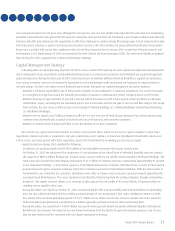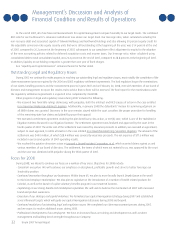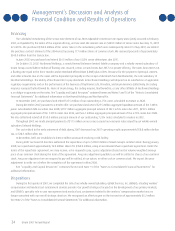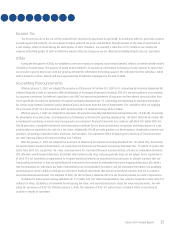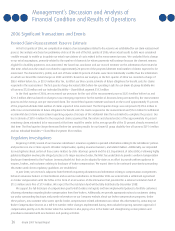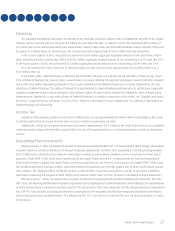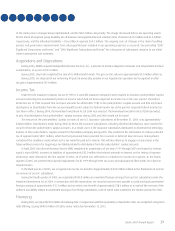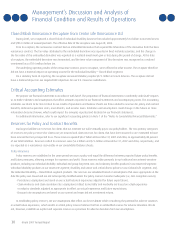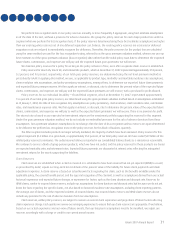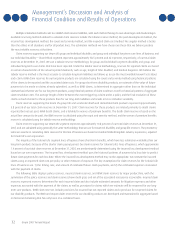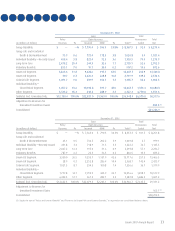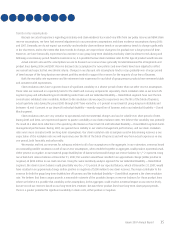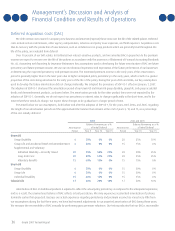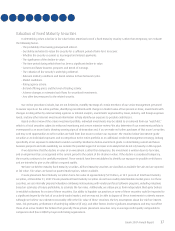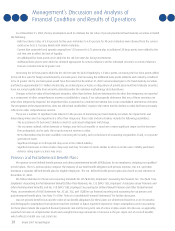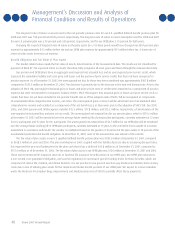Unum 2007 Annual Report Download - page 33
Download and view the complete annual report
Please find page 33 of the 2007 Unum annual report below. You can navigate through the pages in the report by either clicking on the pages listed below, or by using the keyword search tool below to find specific information within the annual report.
Unum 2007 Annual Report 31
We perform loss recognition tests on our policy reserves annually, or more frequently if appropriate, using best estimate assumptions
as of the date of the test, without a provision for adverse deviation. We group the policy reserves for each major product line within a
segment when we perform the loss recognition tests. If the policy reserves determined using these best estimate assumptions are higher
than our existing policy reserves net of any deferred acquisition cost balance, the existing policy reserves are increased or deferred
acquisition costs are reduced to immediately recognize the deficiency. Thereafter, the policy reserves for the product line are calculated
using the same method we used for the loss recognition testing, referred to as the gross premium valuation method, wherein we use our
best estimate as of the gross premium valuation (loss recognition) date rather than the initial policy issue date to determine the expected
future claims, commissions, and expenses we will pay and the expected future gross premiums we will receive.
We maintain policy reserves for a policy for as long as the policy remains in force, even after a separate claim reserve is established.
Policy reserves for Unum US, Unum UK, and Colonial Life products, which at December 31, 2007 represented approximately 31.8 percent,
0.2 percent, and 9.0 percent, respectively, of our total gross policy reserves, are determined using the net level premium method as
prescribed by GAAP. In applying this method, we use, as applicable by product type, morbidity and mortality incidence rate assumptions,
claim resolution rate assumptions, and policy persistency assumptions, among others, to determine our expected future claim payments
and expected future premium income. We then apply an interest, or discount, rate to determine the present value of the expected future
claims, commissions, and expenses we will pay and the expected future premiums we will receive, with a provision for profit allowed.
Policy reserves for our Individual Disability — Closed Block segment, which at December 31, 2007, represented approximately
13.6 percent of our total gross policy reserves, are determined using the gross premium valuation method based on assumptions established
as of January 1, 2004, the date of loss recognition. Key assumptions are policy persistency, claim incidence, claim resolution rates, commission
rates, and maintenance expense rates. We then apply an interest, or discount, rate to determine the present value of the expected future
claims, commissions, and expenses we will pay as well as the expected future premiums we will receive. There is no provision for profit.
The interest rate is based on our expected net investment returns on the investment portfolio supporting the reserves for this segment.
Under the gross premium valuation method, we do not include an embedded provision for the risk of adverse deviation from these
assumptions. Gross premium valuation assumptions do not change after the date of loss recognition unless reserves are again determined
to be deficient. We perform loss recognition tests on the policy reserves for this block of business quarterly.
The Other segment includes products no longer actively marketed, the majority of which have been reinsured. Policy reserves for this
segment represent $5.5 billion on a gross basis, or approximately 45.4 percent, of our total policy reserves. We have ceded $3.9 billion of the
related policy reserves to reinsurers. The ceded reserve balance is reported in our consolidated balance sheets as a reinsurance recoverable.
We continue to service a block of group pension products, which we have not ceded, and the policy reserves for these products are based
on expected mortality rates and retirement rates. Expected future payments are discounted at interest rates reflecting the anticipated
investment returns for the assets supporting the liabilities.
Claim Reserves
Claim reserves are established when a claim is incurred or is estimated to have been incurred but not yet reported (IBNR) to us and,
as prescribed by GAAP, equals our long-term best estimate of the present value of the liability for future claim payments and claim
adjustment expenses. A claim reserve is based on actual known facts regarding the claim, such as the benefits available under the
applicable policy, the covered benefit period, and the age and occupation of the claimant, as well as assumptions derived from our actual
historical experience and expected future changes in experience for factors such as the claim duration and discount rate. Reserves for
IBNR claims, similar to incurred claim reserves, include our assumptions for claim duration and discount rates but because we do not yet
know the facts regarding the specific claims, are also based on historical incidence rate assumptions, including claim reporting patterns,
the average cost of claims, and the expected volumes of incurred claims. Our incurred claim reserves and IBNR claim reserves do not
include any provision for the risk of adverse deviation from our assumptions.
Claim reserves, unlike policy reserves, are subject to revision as current claim experience and projections of future factors affecting
claim experience change. Each quarter we review our emerging experience to ensure that our claim reserves are appropriate. If we believe,
based on our actual experience and our view of future events, that our long-term assumptions need to be modified, we adjust our
reserves accordingly with a charge or credit to our current period income.


